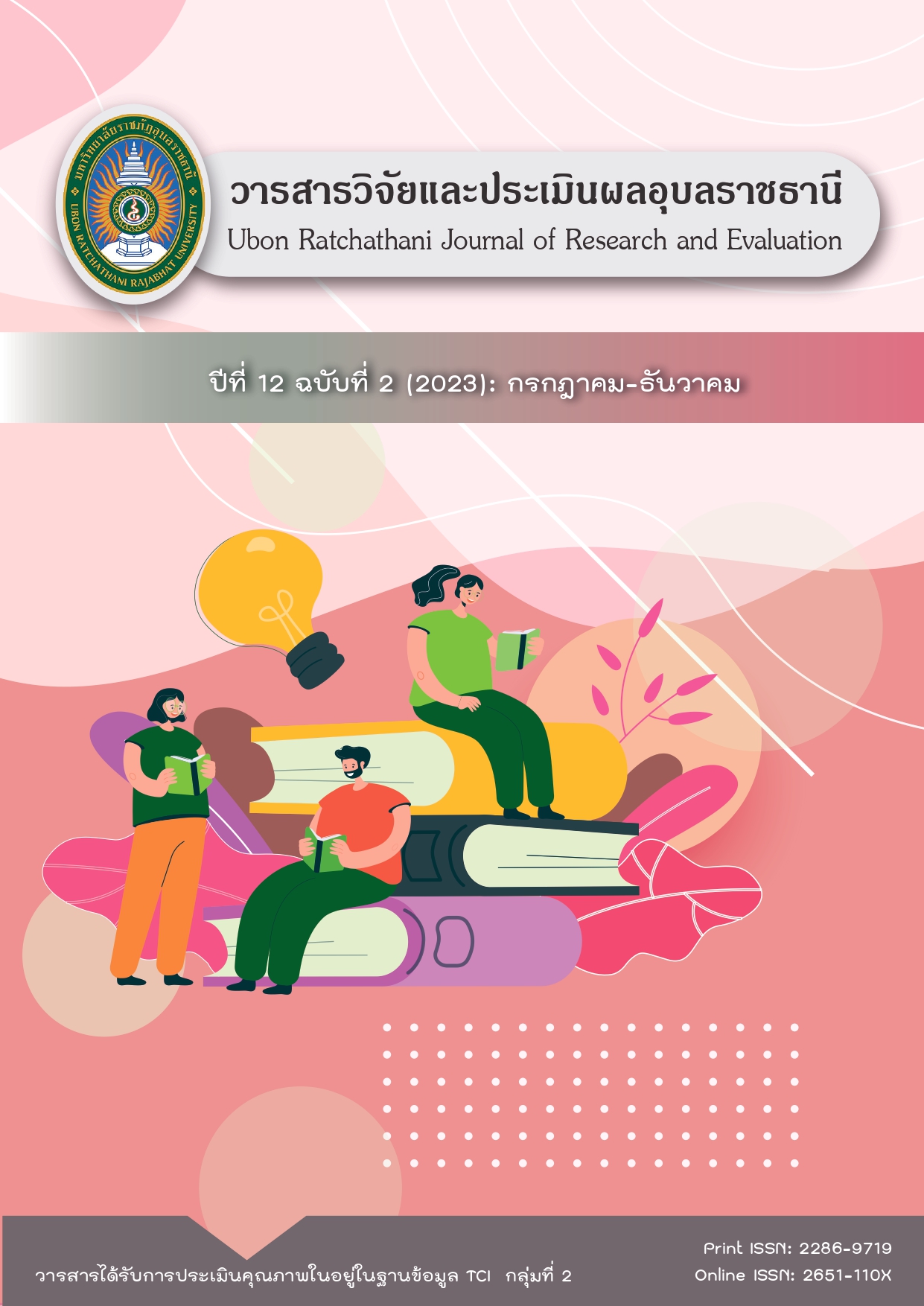การประเมินโครงการพัฒนาสื่อเทคโนโลยีและนวัตกรรมทางการศึกษา เพื่อเสริมสร้างทักษะภาษาอังกฤษ โดยใช้แนวคิดโมเดลเชิงตรรกะ
คำสำคัญ:
การประเมินโครงการ, โมเดลเชิงตรรกะ, การพัฒนาสื่อเทคโนโลยีและนวัตกรรมทางการศึกษาบทคัดย่อ
การวิจัยครั้งนี้เป็นการวิจัยเชิงประเมินมีวัตถุประสงค์ คือ 1) เพื่อพัฒนาองค์ประกอบและตัวบ่งชี้ที่มีผลต่อการพัฒนาสื่อเทคโนโลยีและนวัตกรรมทางการศึกษาเพื่อเสริมสร้างทักษะภาษาอังกฤษ 2) เพื่อประเมินโครงการ และ
3) เพื่อจัดทำข้อเสนอแนะโครงการตามโมเดลเชิงตรรกะ แหล่งข้อมูล ประกอบด้วย 1) เอกสารและรายงานโครงการ และ 2) บุคคลที่เกี่ยวข้อง ได้แก่ ผู้บริหาร ครู บุคลากรผู้รับผิดชอบโครงการ และนักเรียนของโรงเรียนในเครือข่ายสถานศึกษาที่ 10 เขื่องใน 3 เครื่องมือที่ใช้ในการเก็บรวบรวมข้อมูล คือ 1) แบบบันทึกการศึกษาเอกสาร 2) แบบสัมภาษณ์ ซึ่งมีความตรงเชิงเนื้อหา(ค่า IOC เท่ากับ 1.00) และมีค่าความสอดคล้องระหว่างผู้ประเมินอยู่ในระดับสูง (ค่า RAI ตั้งแต่ .80 – .87) การเก็บรวบรวมข้อมูล ผู้วิจัยทำการวิเคราะห์เอกสารของโครงการและสังเคราะห์เป็นองค์ประกอบและตัวบ่งชี้ ผู้วิจัยดำเนินการเก็บรวบรวมข้อมูล โดยใช้คู่มือการประเมินโครงการ และผู้วิจัยทำการสัมภาษณ์ผู้ที่มีส่วนเกี่ยวข้องในการดำเนินโครงการ สถิติที่ใช้ในการวิเคราะห์ข้อมูล ได้แก่ ความถี่ ร้อยละ ค่าเฉลี่ย ส่วนเบี่ยงเบนมาตรฐาน และการวิเคราะห์เนื้อหา
ผลการวิจัยพบว่า
- องค์ประกอบและตัวบ่งชี้ที่มีผลต่อการพัฒนาสื่อเทคโนโลยีและนวัตกรรมทางการศึกษาเพื่อเสริมสร้างทักษะภาษาอังกฤษ ประกอบด้วย 1) บริบทของโครงการ 3 ตัวบ่งชี้ 2) ปัจจัยนำเข้า 4 ตัวบ่งชี้ 3) กระบวนการหลักในโครงการ 3 ตัวบ่งชี้ และ 4) ผลลัพธ์ของโครงการ 5 ตัวบ่งชี้
- ผลการประเมิน พบว่า ผลการประเมิน 2.1) ด้านบริบทของโครงการ อยู่ในระดับ มาก (ค่าเฉลี่ย 3.42) ผ่านเกณฑ์ที่กำหนด โดยโรงเรียน มีความพร้อมเป็นทุนเดิมก่อนดำเนินโครงการอยู่มากทั้งในด้านทรัพยากร และภาคีที่มีประสบการณ์ร่วมดำเนินการ 2.2) ด้านปัจจัยนำเข้าอยู่ในระดับ ปานกลาง (ค่าเฉลี่ย 3.37) ไม่ผ่านเกณฑ์ที่กำหนด โดยโรงเรียนมีบุคลากรที่เข้าใจโครงการทุกระดับทุกฝ่าย มีการวางแผนและวิธีการบริหารจัดการเป็นลายลักษณ์อักษร มีทรัพยากรครบทุกงาน แต่มีปริมาณไม่เพียงพอต่อการดำเนินงาน 2.3) ด้านกระบวนการหลักในโครงการอยู่ในระดับ ปานกลาง (ค่าเฉลี่ย 3.39) ไม่ผ่านเกณฑ์ที่กำหนด โดยโรงเรียนมีการปฏิบัติงานตามแผนที่กำหนดไว้อย่างครบถ้วนทุกกิจกรรม แต่การกำกับควบคุมให้มีการปฏิบัติงานยังไม่สอดคล้องตามระยะเวลาที่กำหนดไว้ และ 2.4) ด้านผลผลิต/ผลลัพธ์ของโครงการอยู่ในระดับ ปานกลาง (ค่าเฉลี่ย 3.27) ไม่ผ่านเกณฑ์ที่กำหนด โดยโรงเรียนมีผลการดำเนินโครงการตั้งแต่ระดับปานกลางถึงระดับมากที่สุด (ค่าเฉลี่ยตั้งแต่ 2.67 – 4.33) และมีสื่อเทคโนโลยีและนวัตกรรมทางการศึกษาเพื่อเสริมสร้างทักษะภาษาอังกฤษที่มีจำนวนน้อย
- ข้อเสนอแนะในการพัฒนาสื่อเทคโนโลยีและนวัตกรรมทางการศึกษาเพื่อเสริมสร้างทักษะภาษาอังกฤษตามโมเดลเชิงตรรกะ โรงเรียนควรมุ่งเน้นกระบวนการหลักในการดำเนินงานโดยส่งเสริมการแลกเปลี่ยนเรียนรู้ การมีภาคียุทธศาสตร์สนับสนุนโครงการ การติดตาม และประเมินผลระหว่างดำเนินงาน
เอกสารอ้างอิง
กรมวิชาการ. การวิจัยเพื่อพัฒนาการเรียนรู้ตามหลักสูตรการศึกษาขั้นพื้นฐาน. กรุงเทพฯ: โรงพิมพครุสภา
ลาดพร้าว, 2545.
กลุ่มงานติดตามผลและประเมินผล สำนักนโยบายและแผน สำนักงานเลขาธิการวุฒิสภา.
ชนิตา ไกรเพชร และคณะ. (2556). การพัฒนาระบบการประเมินประสิทธิผลองค์กรสำหรับ
สถาบันอุดมศึกษาสังกัดกระทรวงการท่องเที่ยวและกีฬา. วารสารครุศาสตร์. ปีที่ 41 ฉบับที่
(ตุลาคม-ธันวาคม). หน้า 69-82.
น้ำเพชร ศรีวิจิตรโชค. (2555). การประเมินผลโครงการประเมินผลการปฏิบัติราชการตามคำรับรองการ
ปฏิบัติราชการของสำนักงานเลขาธิการวุฒิสภาด้วยตัวแบบเชิงตรรกะ (Logic Model).
สุวิมล ว่องวาณิช. (2552). การออกแบบและประเมินโครงการโดยใช้ทฤษฎีการเปลี่ยนแปลง.วารสารการ
วิจัยสังคมศาสตร์. สมาคมวิจัยสังคมศาสตร์แห่งประเทศไทย
สุวิมลว่องวาณิช. (2552). หน่วยที่ 7: การวิจัยประเมินผล. กรุงเทพมหานคร:
มหาวิทยาลัยสุโขทัยธรรมาธิราช.
สุวิมล ว่องวาณิช. (2550). การวิจัยประเมินความต้องการจําเป็น.กรุงเทพมหานคร:
สํานักพิมพ์แห่งจุฬาลงกรณ์ มหาวิทยาลัย.
Clarke, A. & Dawson, R. (1999). Evaluation research. Thousand Oaks, CA: Sage
Publications Ltd.
Chen, H.T. (2005). Practical program evaluation. Thousand Oaks: CA: Sage Publications,
Inc.
Imas, L.G.M. & Rist, R.C. (2009). The road to results: Designing and conducting
effectiveness development evaluations. Washington DC: The World Bank.
McLaughlin, J.A. & Jordan, G.B. Logic model: A tool for telling your programs
performance story.
In Elliot Stern (ed.) (pp. 62-77). Evaluation Research Methods (Volume III). Thousand
Oaks, CA: Sage Publications, Inc.
Rogers, P.J. (2005). Program theory: Not whether programs work but how they work. In
Elliot Stern (ed.) (pp. 3-30). Evaluation Research Methods (Volume III). Thousand Oaks, CA: Sage Publications,Inc.
Scriven, M. (1995). Evaluation as a discipline. Studies in Educational Evaluation. 20-147-166.
Scriven, M. (1995). Minimalist theory : The least theory that practice requires. American
Journal of Evaluation. 19(1):. 57 - 70.
W W.K. Kellogg Foundation. (2009). Logic model development guide.
http://www.wkkf.org Retrieved 10/01/2009.
Andrea A. Anderson. (2010). The Community Builder’s Approach to Theory of
Change.Roundtable on community change, The Aspen institute, p.1-10.
Helitzer, Deborah.; et al. (2010) . Evaluation for community-based programs: The
integration of logic models and factor analysis. Evaluation and program
planning, 33, 223- 233.
ดาวน์โหลด
เผยแพร่แล้ว
รูปแบบการอ้างอิง
ฉบับ
ประเภทบทความ
สัญญาอนุญาต
ลิขสิทธิ์ (c) 2023 วิจัยและประเมินผลอุบลราชธานี

อนุญาตภายใต้เงื่อนไข Creative Commons Attribution-NonCommercial-NoDerivatives 4.0 International License.
1. บทความที่ตีพิมพ์ในวารสารนี้ได้มีการตรวจสอบการลอกเลียนงานวรรณกรรมแล้ว ไม่เกินร้อยละ 25
2. บทความที่ตีพิมพ์ในวารสารนี้เป็นข้อคิดเห็น ข้อค้นพบของผู้เขียนบทความ โดยผู้เขียนบทความต้องเป็นผู้รับผิดชอบต่อผลทางกฎหมายใด ๆ ที่อาจเกิดขึ้นจากบทความนั้น ๆ
3. บทความ ข้อมูล เนื้อหา รูปภาพ ฯลฯ ที่ได้รับการตีพิมพ์ในวารสารวิจัยและประเมินผลอุบลราชธานี ถือเป็นลิขสิทธิ์ของวารสารวิจัยและประเมินผลอุบลราชธานี หากบุคคลหรือหน่วยงานใดต้องการนำทั้งหมดไปเผยแพร่ต่อหรือเพื่อกระทำการใดๆ จะต้องได้รับอนุญาตเป็นลายลักษณ์อักษรจากวารสารวิจัยและประเมินผลอุบลราชธานีก่อนเท่านั้น และจะต้องมีการอ้างอิงวารสารวิจัยและประเมินผลอุบลราชธานี ฉบับนั้น ๆ ด้วย






